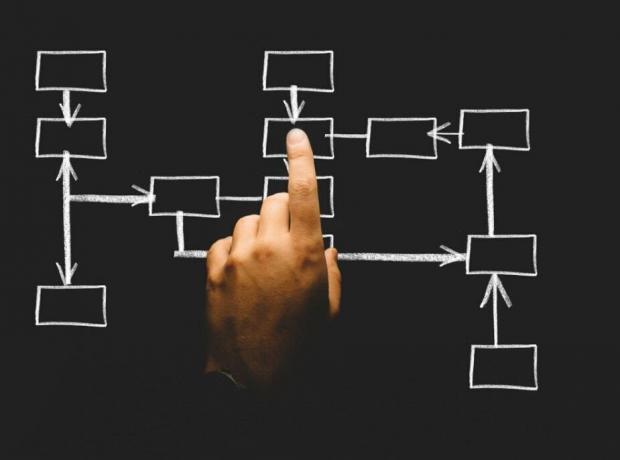You have probably heard of the term "process mapping" or also known as a business process mapping (both terms are used interchangeably) to describe a process. However, what exactly is process mapping?
Process mapping is a tool that it is used to visualize the steps involved in a business process from the beginning to the end. This visualization draws a concise picture of the sequences of tasks required to take a product or service from genesis to completion.
Advertisements
It is often represented as a flow chart and generally moves from left to right or sometimes top to bottom.
On the other hand, business process mapping is part of the workflow management practices, which also include business process modeling that can provide a more detailed representation of a process that generally incorporates additional organizational material.
Advertisements

This documentation process has to do with what a company does, why it does what it does, what is the standard for success, who is responsible, and when and where the different will occur Steps.
Advertisements
Process mapping promotes transparency, not just for those within the company, but for all stakeholders, especially those involved in compliance.
In this article you will find:
Process modeling vs process mapping
Business process mapping often gets confused with business process modeling. When professionals perform business process modeling, they are more interested in how the processes are performed and who (or what department) is performing them. This is the main difference.
Advertisements
Modeling is more about how processes flow, while mapping is about what exists
Types of business process mapping
There are many different types of process mapping, ranging from planning activities, details, documents, products, roles, locations, strategies and interactions.
Advertisements
In addition, various levels of detail are available for mapping. Here are some examples of map types for business processes.
- Flowcharts: There are three popular types of flowcharts: top-down flowcharts, deployment flowcharts, and detailed flowcharts. Top-down flowcharts show the steps in a process, grouping them into a single flow. Deployment flowcharts are a top-down flowchart expanded to include who performs what task. Detailed flowcharts are an expansion of the deployment and top-down flowcharts, showing as much detail as possible.
- Lane diagrams- These diagrams, also known as cross-functional maps, detail the responsibilities of the sub-process in a process.
- State diagrams: These diagrams show the behavior of systems in the Unified Modeling Language (UML), describing the states of the component.
- Data flow diagram- Similar to a flow chart, this chart focuses solely on the data flowing through a system.
- Value stream mapping- Part of the principles of Lean Manufacturing, value stream mapping demonstrates the current state and helps to design the future state of a process, focusing on taking products and services from its inception to its ending.
Profits
The benefits are numerous. The following are some of the reasons why an organization would want to map processes:
- Let everyone see the process in the same way.
- Reduces procedural errors.
- Develop understanding between areas that are multifunctional.
- Help everyone to see the "current state."
- It allows the development of metrics.
- Reduce waste by identifying gaps and excesses.
Business process mapping uses various symbols to indicate different parts of the process. Among the main ones are the following:
- Oval - Used to indicate start and end points, for example.
- Rectangle - is a process chart used to indicate specific steps or tasks that need to be completed and possibly who does it and how long it takes.
- Diamond - A diamond is used to represent a decision point in the process. This is a point where a yes or no (or true or false) answer is needed.
- Arrows - Arrows, or connectors, show how one point in the process leads to another.
To properly transform an organization into a sustainable one, you must understand how to start mapping business processes. These following principles should be present in every mapping project:
- Define the scope of the project itself, with boundaries, start and end points.
- Look at the big picture: the intent of the process.
- Define each step clearly.
- Get feedback from everyone in your organization who is involved in the process.
- Strive to be complete in your accuracy, especially with the process map "as is."
- Strive to keep threads simple.
- Test the process with accepted metrics. The metrics should measure time, volume, fees / costs, equipment, and any added value.
- It works from exit to entrance, backwards.
- Create the property with single touch points when possible.
- Redesign processes to be customer-centric.
- Use technology to enable your processes.
- Reduces inefficiencies in transfers.
Today's companies are more focused than ever on sustainable improvement. Even with measurable operational improvements, it can be difficult to sustain the improvements made. Many companies still have inefficient processes and see technology as a magic solution that can solve their problems in one fell swoop.
Experts say that these technologies can certainly help, but judicious use of them is required in a systematic review of the processes and in the development of maps.
In this way, the sustainability of the improvement of processes and businesses is possible. In addition, the organization must make cultural improvements, since the development of technology to develop Process maps have far exceeded the ability of most organizations to implement them.
Without cultural shifts, the people involved in the process can easily sink improvements before they take hold.


